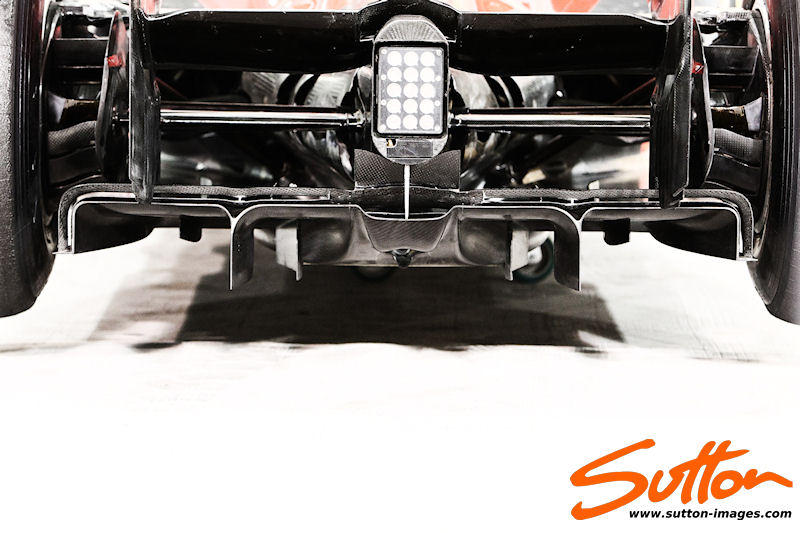
via @SomersF1


or the fact that they did improve a tenth or so, but the rest of the field improved half a second over a week. Alonso said he gave it all he had, 7th place is a reflection of the car's pacedonskar wrote:Well, Ferrari's updates did change the F2012's performance -- it qualified worse.

Sorry but have to say that RBR and Ferrari are not using the same concept for their FW, may be thats because RBR found a way to flex its FW but if you sees the endplate design then you will see that while RBR8 completely deflect air flow around the wheel while F2012's endplate deflect some air around wheel and direct some towards the break duct and due to the vertical flap over the endplate of F2012 it seems that they are actually trying to direct the air toward the sidepod more, then just deflectingvariante wrote:Those slots have nothing to do with wheel interaction: they direct air on the upper surface of the wing, increasing the pressure (and the downforce) on that area. Also, i think (but i'm not sure) that the last two slots decrease the stalling chances of the wing by feeding it with high pressure air.richard_leeds wrote:Good point, those holes direct air inwards, it does seem very odd.tok-tokkie wrote:I am really puzzled by the Ferrari front wing end plates.
...
But Ferrari seem to be taking the air from the outside in towards the front wheel with all the holes/slots in the end plate.
Moreover, Ferrari and Red Bull are using an almost identical front wing design, so no difference between air deflection around the wheel.
The updates to the F2012 worked, thankfully as its a good sign for the rest of the year & next. But as you said, others improved too. But.. Abu Dhabi has never really been a strong track for Ferrari. It's characteristics don't suit the F2012 like it does other cars.Teechnical wrote:or the fact that they did improve a tenth or so, but the rest of the field improved half a second over a week. Alonso said he gave it all he had, 7th place is a reflection of the car's pacedonskar wrote:Well, Ferrari's updates did change the F2012's performance -- it qualified worse.


Sorry but I have to disagree... the differences are really minimal, and the concept is the same:F1.Ru wrote:Sorry but have to say that RBR and Ferrari are not using the same concept for their FW, may be thats because RBR found a way to flex its FW but if you sees the endplate design then you will see that while RBR8 completely deflect air flow around the wheel while F2012's endplate deflect some air around wheel and direct some towards the break duct and due to the vertical flap over the endplate of F2012 it seems that they are actually trying to direct the air toward the sidepod more, then just deflecting



Hey thanks for the link, it seems that you are well aware about the problem Ferrari suffering. Yet what i m trying to say is that now Ferrari dont have any other option apart from track testing. As they have CFD but can not fully relies on them, have WT but also have correlation issues which they can not trust, so left is only track testing..............munudeges wrote:viewtopic.php?f=15&t=12096&p=387922#p387922F1.Ru wrote:It seems that you forget Ferrari is suffering correlation issues with its windtunnel, so the data that have been produced by cologen WT may differ from their original data and due to that they have little time for testing different combination on WT. Moreover you should not forget that a specific parts can produce different result in different track, as track itself is the major influence on the car setup and over the parts that has been used.
I'm well aware of the problems they've been having for over a couple of years now, but I'm afraid track time is a precious commodity they don't have.

The major difference that you forget is not the orientation of the flap rather what i am saying is the holes in the endplate. Ferrari used holes for scooping some of the air towards the break duct where RBR used their FW flaps for doing so.variante wrote:Sorry but I have to disagree... the differences are really minimal, and the concept is the same:F1.Ru wrote:[................]
http://finemodelcars.com/blog/wp-conten ... -Web-2.jpg
http://i45.tinypic.com/v8o5lz.jpg






yes, we were talking about air flow deviation, and indeed there's no way those slots in the endplates can influence as much as you say the flow.F1.Ru wrote:The major difference that you forget is not the orientation of the flap rather what i am saying is the holes in the endplate. Ferrari used holes for scooping some of the air towards the break duct where RBR used their FW flaps for doing so.
They dont create downforce per se, but they keep constant downforce by keeping the flow attached in this outer section. This is useful under low ride height situations, for example under braking, where the wing area has less chance of stalling, thus delivering the downforce.illario wrote:I don't want to offend anyone's knowledge(i understand little about AIR)...shouldn't the holes create more down force when the car goes on the corners. I'm imagining more AIR going under the 3, 4, 5, 6 when the car is turning.